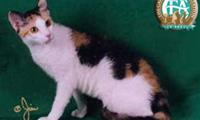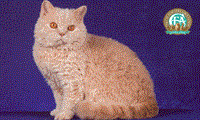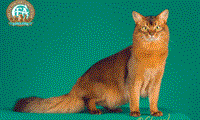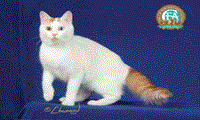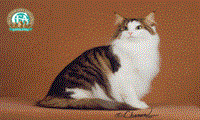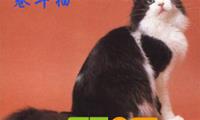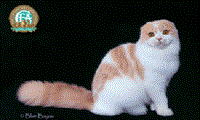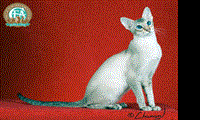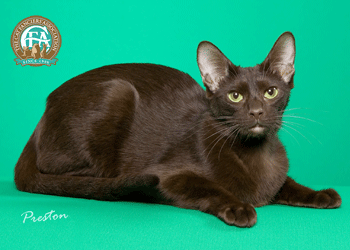
美國CFA官方關於哈瓦納棕毛貓的品種介紹的中文翻譯和英文原文。
英 文 名:Havana brown.
如同緬甸貓一樣, 英國和大西洋彼岸的美國對這種貓判斷的標準不同。
歷史起源
這是20世紀50年代初, 由英國的畜牧學家培育出來的, 是巧克力色點暹羅貓與英國土著的短毛貓雜交品種。 由於其體毛、鬍鬚、鼻子都是褐色的, 與古巴著名的哈瓦那雪茄煙顏色一樣, 因而取名為哈瓦那貓, 意為雪茄煙色貓。
原產地:英國。
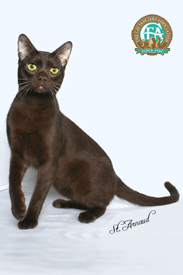
性格:
富有活力, 非常愛玩, 熱情含蓄, 一派紳士風度;戀家, 對人親切, 但是要求人給予格外關注;叫聲殷勤, 母子貓之間總是說個不停, 母貓對子女盡心盡力。
繁殖方式: 胎生。
頭部:頭長, 呈楔形。
耳朵: 大, 尖呈圓弧形。
眼睛:杏仁形, 吊眼, 為綠色。
鼻子: 鼻子短直。
下巴: 四肢 細長, 前肢比後肢略短。
足掌: 腳爪小, 為橢圓形。
尾巴: 尾長。
披毛: 毛很短有光澤。
毛色: 毛色為均勻的鮮栗褐色。
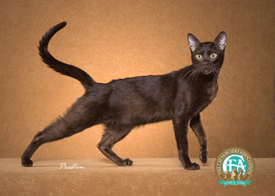
CFA官方關於哈瓦納棕毛貓的品種介紹的英文原文:
Breed Profile: Havana Brown
In terms of history, the Havana Brown is a hybrid or man-made breed. This delightful self-chocolate cat is the result of carefully planned breeding for a specific genetic design. Documentation indicates that self-brown Siamesetype cats existed in England and Europe in the late 1800. The Encyclopedia Britannica, 11th Edition, mentions a holly chocolate-coloured strain of Siamese.?One name given to these self-brown cats was wiss Mountain Cat.?
In the 1920, the Siamese Cat Club of Britain discouraged the breeding of any ut blue-eyed Siamese?and the breed was abandoned. In the early 1950, a group of English breeders worked together to produce a self-brown cat. The cats used were a black domestic and a seal or chocolate point Siamese. Reportedly, an occasional Russian Blue was also used. The name Havana Brown was used for the first time to describe the color genetics for self-browns.
The first Havana Brown was imported into North America in the mid 1950抯. The breed was accepted for registration by CFA in 1959 and was granted Championship status in 1964. Records and old pedigrees reveal that some North American breeders introduced Russian Blues and Siamese into their early breeding programs. This practice came to an end when the breed was closed to outcross breeding in 1974.
In England, the Havana has tended to follow the type of the Siamese and the word rown?has been dropped from the breed name while breeders in North America have maintained the name and the look of the early imports. In 1998, in an effort to increase the gene pool, breeders received approval from CFA to open the breed to outcross breeding to unregistered black or blue domestic shorthairs or certain colors of Oriental Shorthairs. In 1999, approval was also received for the use of chocolate point or seal point Siamese with full Havana Browns. CFA抯 8th Best Cat in Championship for the 2004-2005 show season (the cat pictured on the front cover at the top of this pamphlet) is a product of the outcross program. This beautiful male, along with his achievement, is a true testament to the success of the program.
What makes a Havana Brown unique? The first thing an admirer notices is the glistening mahogany-toned glossy brown coat. The coat is smooth, lustrous, closelying and feels like a luxurious mink. A rich, evenly colored shade of warm chocolate brown tending more to redbrown is desirable. Their other incomparable feature is the distinctive head that is slightly longer than it is wide. In profile, the prominent broad nose has a definite stop at the eyes. A pronounced whisker pinch combined with the strong square chin forms a somewhat rounded muzzle. Viewed from above or felt with the fingertips, the pronounced break in the bone structure behind each whisker pad is evident in good specimens. The enticing green, oval-shaped eyes in combination with large, forward tilted ears contribute to their alert sweet expression.
Picking up a Havana Brown for the first time can be a surprising experience, as this lithe-looking cat weighs more than it appears. Its medium-sized body must be firm and muscular, exhibiting a sense of power, yet also exhibit elegance and gracefulness. Males tend to be larger than their female counterparts, usually weighing around eight to ten pounds, while the females average six to eight.
Several theories exist as to how the breed got its name. Some historians insist it was named after the rabbit of the same color; however, most Havana Brown fans choose to believe that the breed name refers to the color of a fine Havana cigar.
Kittens are born brown, all brown. Ghost tabby markings are allowed in kittens; however, the ideal is a solid color coat free of any markings whatsoever. Whiskers must be brown to complement the coat color.
The Havana Brown has a charming, playful manner and a soft, intimate voice. They often extend a paw as a means of contact or attempt to gain the attention of passersby as well as using their paws to investigate curiosities by touching and feeling. A people-oriented breed, they quietly demand human companionship and adapt to most situations. This is the perfect cat for the person who wants a sociable, affectionate and intelligent feline friend. A cat who is as sweet in appearance and color ashocolate.
Pricing on Havana Browns usually depends on type, applicable markings and bloodlines distinguished by Grand Champion (GC), National or Regional winning parentage (NW or RW) or of Distinguished Merit parentage (DM). The DM title is achieved by the dam (mother) having produced five CFA grand champion/premier (alter) or DM offspring, or sire (father) having produced fifteen CFA grand champion/premier or DM offspring. Usually breeders make kittens available between twelve and sixteen weeks of age. After twelve weeks, kittens have had their basic inoculations and developed the physical and social stability needed for a new environment, showing, or being transported by air. Keeping such a rare treasure indoors, neutering or spaying and providing acceptable surfaces (e.g. scratching posts) for the natural behavior of scratching (CFA disapproves of declawing or tendonectomy surgery) are essential elements for maintaining a healthy, long and joyful life.
